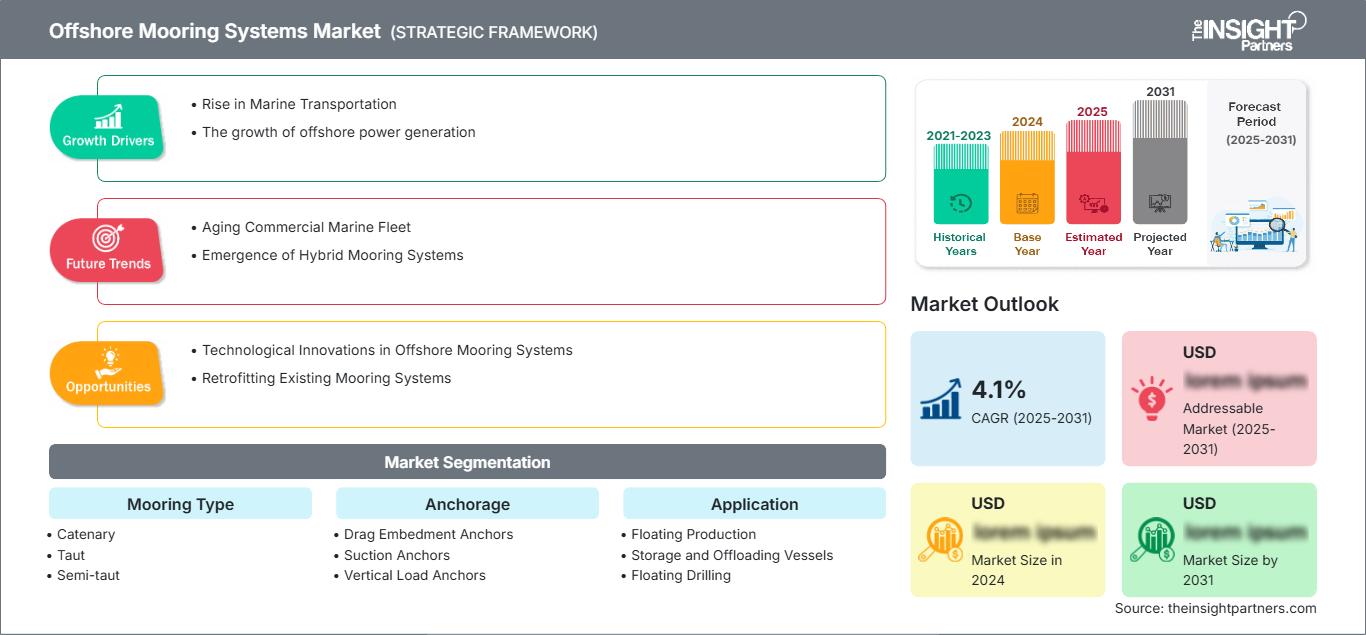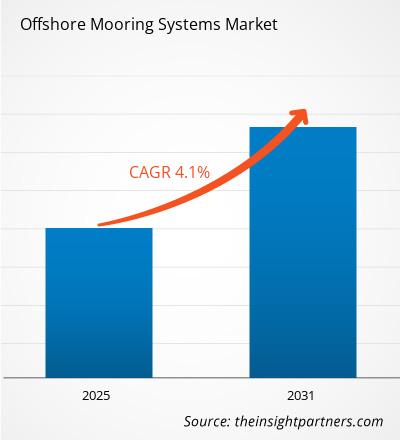Der Markt für Offshore-Verankerungssysteme wird voraussichtlich zwischen 2025 und 2031 eine durchschnittliche jährliche Wachstumsrate (CAGR) von 4,1 % verzeichnen, wobei die Marktgröße von XX Millionen US-Dollar im Jahr 2024 auf XX Millionen US-Dollar im Jahr 2031 anwachsen wird.
Der Bericht ist nach Verankerungstyp (Ketten-, Straff-, Halbstraff-, Spreiz-, Einzelpunkt- und dynamische Positionierungsanker), Verankerung (Schleppanker, Sauganker und vertikale Lastanker) und Anwendung (schwimmende Produktions-, Lager- und Entladeschiffe (FPSO), schwimmende Bohr-, Produktions-, Lager- und Entladeschiffe (FDPSO), schwimmende Flüssigerdgasschiffe (FLNG), Zugbeinplattformen, Halbtaucher, Spar-Plattformen und andere) segmentiert. Die globale Analyse ist weiter auf regionaler Ebene und nach den wichtigsten Ländern aufgeschlüsselt. Der Bericht bietet den Wert in USD für die oben genannte Analyse und Segmente.
Zweck des Berichts
Der Bericht „Offshore Mooring Systems Market“ von The Insight Partners zielt darauf ab, die aktuelle Situation und das zukünftige Wachstum sowie die wichtigsten treibenden Faktoren, Herausforderungen und Chancen zu beschreiben. Dies wird verschiedenen Geschäftspartnern Einblicke bieten, wie z. B.:
- Technologieanbieter/-hersteller: Um die sich entwickelnde Marktdynamik zu verstehen und die potenziellen Wachstumschancen zu kennen, damit sie fundierte strategische Entscheidungen treffen können.
- Investoren: Um eine umfassende Trendanalyse hinsichtlich der Marktwachstumsrate, der finanziellen Marktprognosen und der Chancen entlang der Wertschöpfungskette durchzuführen.
- Regulierungsbehörden: Um Richtlinien und Polizeiaktivitäten auf dem Markt zu regulieren, mit dem Ziel, Missbrauch zu minimieren, das Vertrauen der Investoren zu bewahren und die Integrität und Stabilität des Marktes aufrechtzuerhalten.
Marktsegmentierung für Offshore-Verankerungssysteme: Verankerungstyp
- Kettenlinie
- Gespannt
- Halbgespannt
- Gespreizt
- Einzelpunkt
- Dynamische Positionierung
Verankerung
- Schleppverankerungsanker
- Sauganker
- Vertikallastanker
Anwendung
- Schwimmende Produktions-
- Lager- und Entladeschiffe
- Schwimmende Bohr-
- Produktions-
- Lager- und Entladeschiffe
- Schwimmende Flüssigerdgasschiffe
- Zugbeinplattform
- Halbtaucher
- Sparplattformen
Geographie
- Nordamerika
- Europa
- Asien-Pazifik
- Süd- und Mittelamerika
- Naher Osten und Afrika
Sie erhalten kostenlos Anpassungen an jedem Bericht, einschließlich Teilen dieses Berichts oder einer Analyse auf Länderebene, eines Excel-Datenpakets sowie tolle Angebote und Rabatte für Start-ups und Universitäten.
Markt für Offshore-Verankerungssysteme: Strategische Einblicke

-
Holen Sie sich die wichtigsten Markttrends aus diesem Bericht.Dieses KOSTENLOSE Beispiel umfasst Datenanalysen, die von Markttrends bis hin zu Schätzungen und Prognosen reichen.
Wachstumstreiber für Offshore-Verankerungsanlagen
- Zunahme des Seetransports: Der Seetransport hat in den letzten Jahren stark zugenommen, da er günstigere Tarife bietet, sich ideal für großvolumige Güter eignet und eine einfache Anbindung an andere Teile der Welt ermöglicht. Einer der Hauptvorteile des Seetransports ist die Möglichkeit der Reedereien, übergroße, schwere Ladungen zu transportieren, die allgemein als Stückgut oder Not-in-Trailer-Ladungen (NIT) bezeichnet werden. Große Fahrzeuge, Ausrüstung, Baumaterialien und andere Gegenstände können als Fracht transportiert werden. Daher wird erwartet, dass der Anstieg des Seetransports den Markt für Offshore-Verankerungssysteme in den kommenden Jahren ankurbeln wird.
- Das Wachstum der Offshore-Stromerzeugung: Der Anstieg der Investitionen in Offshore-Windenergieprojekte, Offshore-Öl- und Gasproduktion sowie Meeresenergieprojekte wird voraussichtlich die Nachfrage nach Schiffen ankurbeln, was wiederum das Wachstum des Marktes für Offshore-Verankerungssysteme in den kommenden Jahren ankurbeln dürfte.
Zukünftige Trends auf dem Markt für Offshore-Verankerungssysteme
- Alternde kommerzielle Schiffsflotte: In fast allen Ländern ist der Großteil der kommerziellen Schiffsflotte veraltet. Laut den von den Vereinten Nationen im Jahr 2023 veröffentlichten Daten betrug das Durchschnittsalter der Schiffe weltweit 22,2 Jahre, und mehr als die Hälfte der Schiffe ist älter als 15 Jahre. Darüber hinaus gab es laut den Daten des US Bureau of Transportation im Jahr 2021 in den USA etwa 27.000 Schiffe, die älter als 15 Jahre sind. Daher wird der Bedarf an der Erneuerung der kommerziellen Flotte steigen, was im Prognosezeitraum positive Wachstumschancen für den Markt für Offshore-Verankerungsanlagen schaffen dürfte.
- Aufkommen hybrider Verankerungsanlagen: Die Entstehung hybrider Verankerungsanlagen, die traditionelle Verankerungsmethoden mit dynamischen Positionierungstechnologien kombinieren, gewinnt an Bedeutung. Dieser Trend verbessert die betriebliche Flexibilität und Anpassungsfähigkeit an unterschiedliche Umweltbedingungen.
Marktchancen für Offshore-Verankerungsanlagen
- Technologische Innovationen bei Offshore-Verankerungsanlagen: Im Laufe der Jahrzehnte haben technologische Fortschritte zu erheblichen Verbesserungen der Verankerungsanlagen geführt. Der Schwerpunkt lag auf der Steigerung der Effizienz, der Verkleinerung und der Verbesserung der Zuverlässigkeit dieser Systeme. Dieser Wandel ermöglichte eine größere Flexibilität und Effizienz bei der Stromerzeugung, um den unterschiedlichen Strombedarf an Bord von Schiffen zu decken. Daher werden technologische Innovationen voraussichtlich der wichtigste Trend auf dem Markt sein.
- Nachrüstung bestehender Verankerungsanlagen: Das Potenzial zur Nachrüstung bestehender Offshore-Verankerungsanlagen mit fortschrittlichen Technologien bietet erhebliche Chancen. Unternehmen können Betreiber ansprechen, die die Leistung und Sicherheit ihrer aktuellen Verankerungslösungen verbessern möchten.
Regionale Einblicke in den Markt für Offshore-Verankerungssysteme
Die Analysten von The Insight Partners haben die regionalen Trends und Faktoren, die den Markt für Offshore-Verankerungssysteme im Prognosezeitraum beeinflussen, ausführlich erläutert. In diesem Abschnitt werden auch die Marktsegmente und die geografische Lage in Nordamerika, Europa, dem asiatisch-pazifischen Raum, dem Nahen Osten und Afrika sowie Süd- und Mittelamerika erörtert.
Umfang des Marktberichts zu Offshore-Verankerungssystemen
| Berichtsattribut | Einzelheiten |
|---|---|
| Marktgröße in 2024 | US$ XX million |
| Marktgröße nach 2031 | US$ XX Million |
| Globale CAGR (2025 - 2031) | 4.1% |
| Historische Daten | 2021-2023 |
| Prognosezeitraum | 2025-2031 |
| Abgedeckte Segmente |
By Verankerungstyp
|
| Abgedeckte Regionen und Länder |
Nordamerika
|
| Marktführer und wichtige Unternehmensprofile |
|
Dichte der Marktteilnehmer für Offshore-Verankerungssysteme: Verständnis ihrer Auswirkungen auf die Geschäftsdynamik
Der Markt für Offshore-Verankerungssysteme wächst rasant. Dies wird durch die steigende Endverbrauchernachfrage aufgrund veränderter Verbraucherpräferenzen, technologischer Fortschritte und eines stärkeren Bewusstseins für die Produktvorteile vorangetrieben. Mit der steigenden Nachfrage erweitern Unternehmen ihr Angebot, entwickeln Innovationen, um den Bedürfnissen der Verbraucher gerecht zu werden, und nutzen neue Trends, was das Marktwachstum weiter ankurbelt.

- Holen Sie sich die Markt für Offshore-Verankerungssysteme Übersicht der wichtigsten Akteure
Wichtige Verkaufsargumente
- Umfassende Abdeckung: Der Bericht analysiert umfassend Produkte, Dienstleistungen, Typen und Endnutzer des Marktes für Offshore-Verankerungssysteme und bietet einen ganzheitlichen Überblick.
- Expertenanalyse: Der Bericht basiert auf dem umfassenden Verständnis von Branchenexperten und Analysten.
- Aktuelle Informationen: Der Bericht gewährleistet Geschäftsrelevanz durch die Berichterstattung über aktuelle Informationen und Datentrends.
- Anpassungsoptionen: Dieser Bericht kann an spezifische Kundenanforderungen angepasst werden und passt sich optimal an die Geschäftsstrategien an.
Der Forschungsbericht zum Markt für Offshore-Verankerungssysteme kann daher dazu beitragen, die Branchensituation und die Wachstumsaussichten zu entschlüsseln und zu verstehen. Obwohl es einige berechtigte Bedenken geben mag, überwiegen die Vorteile dieses Berichts tendenziell die Nachteile.
- Historische Analyse (2 Jahre), Basisjahr, Prognose (7 Jahre) mit CAGR
- PEST- und SWOT-Analyse
- Marktgröße Wert/Volumen – Global, Regional, Land
- Branchen- und Wettbewerbslandschaft
- Excel-Datensatz
Aktuelle Berichte
Erfahrungsberichte
Grund zum Kauf
- Fundierte Entscheidungsfindung
- Marktdynamik verstehen
- Wettbewerbsanalyse
- Kundeneinblicke
- Marktprognosen
- Risikominimierung
- Strategische Planung
- Investitionsbegründung
- Identifizierung neuer Märkte
- Verbesserung von Marketingstrategien
- Steigerung der Betriebseffizienz
- Anpassung an regulatorische Trends






















 Kostenlose Probe anfordern für - Markt für Offshore-Verankerungssysteme
Kostenlose Probe anfordern für - Markt für Offshore-Verankerungssysteme